Chiloschista & Dendrophylax Orchid Care (Ghost Orchids)
Commonly known as Ghost Orchids, the genera Chiloschista and Dendrophylax are leafless orchids in nature that produce 5 to 10 flowers, about a quarter inch in size, on a pendulous spray. These plants are easy to grow and prefer cultivation on cork slabs. Chiloschista species are native to Southeast Asia and Australia. Dendrophylax species are native to Florida, the Bahamas, and Cuba.
Light and Shade
We have found that Ghost Orchids grow well under shaded to semi-shaded light (1000 to 2500 foot-candles). We recommend growing in east or west-facing windows. South-facing windows should only be used if shielded from the sun using a sheer curtain. If using artificial light to grow indoors, LEDs are the best option. The artificial light market has expanded greatly in recent years, so a quick Google search will result in a variety of lighting options and price ranges.
Temperature and Humidity
Ghost Orchids prefer a day temperature range between 70°F and 85°F (21°C to 29°C). At night there should be at least a 10°F (6°C) drop, as Ghost Orchids enjoy nighttime lows from 60°F to 65°F (16°C to 18°C). This lower night temperature will help initiate flower buds in fall and spring. Keep in mind, these are tropical orchids that prefer temperatures above 58°F (14°C). Ghost Orchids benefit from humidity levels of 50% and higher. This can be achieved at home with the use of a humidifier.
Watering
These orchids are exclusively grown on slabs. It is best to use rainwater, distilled or reverse osmosis water. If you have a dehumidifier in your home, the water that collects in the tray is excellent for watering orchids. Alternative sources will cause a mineral build-up on the cork. This in turn will cause an inability of the roots to attach to the cork and create a general decline in the plant. Generally, watering will be every one to three days, depending on the time of year. Misting with fertilizer should be done every week. Incidentally, if you begin to notice that the roots are beginning to shrivel up, that is a sign that you are not watering frequently enough. Green root tips should be evidence of good humidity. We always recommend watering in the morning, as this gives the roots time to dry and avoid bacterial growth overnight.
Feeding
We highly recommend Green Jungle Orchid Food, specially formulated to provide orchids with the nutrients they would naturally encounter in their wild habitats. This is the fertilizer that we developed to use on our own plants in production, with excellent results for decades! This formula works best with water low in alkalinity (such as rainwater, distilled water, or reverse osmosis water). Fertilize with Green Jungle every time you water your Ghost Orchid.
Potting
This plant truly prefers slab mounting. We have found it best to use cork or tree fern slabs. If your cork starts showing heavy algae growth on the outside of it, this is a sign of too much fertilizer. If the slab becomes built up with minerals, it is best to re-mount the plants. This entails soaking the root system first, carefully peeling the plant off its present slab, and then reattaching to a new slab. It can be simply tied on by fishing line or glued on with water-resistant glue.
Flowering
This plant can bloom at any time of the year, however, the spring, summer and fall months seem to be the heaviest times of bloom in the Northern Hemisphere. The tubular, somewhat flat roots, extend in a rosette fashion from the center growth of the plant. With many roots clinging to cork or simply out in the air, they act as the leaves and provide the necessary photosynthesis for the plant. Occasionally there will be one or two very tiny leaves in the center of the growth.
Featured Products
Shop all →





